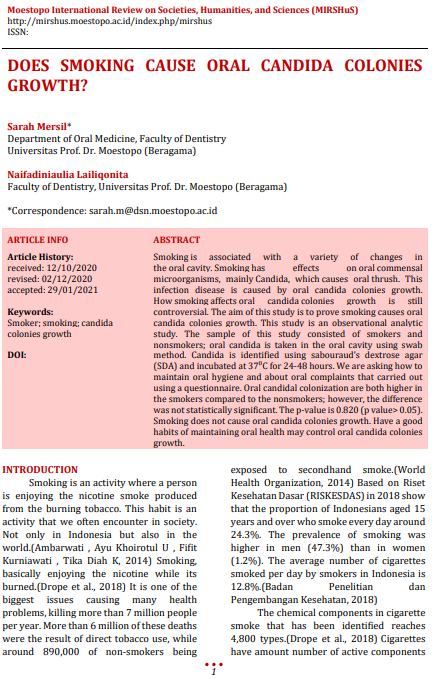DOES SMOKING CAUSE ORAL CANDIDA COLONIES GROWTH?
Abstract
Smoking is associated with a variety of changes in the oral cavity. Smoking has effects on oral commensal microorganisms, mainly Candida, which causes oral thrush. This infection disease is caused by oral candida colonies growth. How smoking affects oral candida colonies growth is still controversial. The aim of this study is to prove smoking causes oral candida colonies growth. This study is an observational analytic study. The sample of this study consisted of smokers and nonsmokers; oral candida is taken in the oral cavity using swab method. Candida is identified using sabouraud’s dextrose agar (SDA) and incubated at 37⁰C for 24-48 hours. We are asking how to maintain oral hygiene and about oral complaints that carried out using a questionnaire. Oral candidal colonization are both higher in the smokers compared to the nonsmokers; however, the difference was not statistically significant. The p-value is 0.820 (p value> 0.05). Smoking does not cause oral candida colonies growth. Have a good habits of maintaining oral health may control oral candida colonies growth.
References
Alanazi, H., Semlali, A., Perraud, L., Chmielewski, W., Zakrzewski, A., & Rouabhia, M. (2014). Cigarette Smoke-Exposed Candida albicans Increased Chitin Production and Modulated Human Fibroblast Cell Responses. BioMed Research International. https://doi.org/10.1155/2014/963156
Ambarwati , Ayu Khoirotul U , Fifit Kurniawati , Tika Diah K, S. D. (2014). Media Leaflet, Video dan Pengetahuan Siswa SD tentang Bahaya Merokok (Studi pada Siswa SDN 78 Sabrang Lor Mojosongo Surakarta). Kemas, 10(1), 7–13. https://doi.org/10.1142/S0218348X98000419
Badan Penelitian dan Pengembangan Kesehatan. (2018). Laporan Nasional Riset Kesehatan Dasar 2018. In Badan Penelitian dan Pengembangan Kesehatan (p. 198).
Becker, T. (2015). The Association between Smoking Habits and Candida in the Oral Cavity. International Journal of Dentistry and Oral Health, 1(2). https://doi.org/10.16966/2378-7090.107
Darwazeh, A. M. G., Hammad, M. M., & Al-Jamaei, A. A. (2010). The relationship between oral hygiene and oral colonization with Candida species in healthy adult subjects*. International Journal of Dental Hygiene, 8(2), 128–133. https://doi.org/10.1111/j.1601-5037.2009.00407.x
Drope, J., Schluger, N., Cahn, Z., Drope, J., Hamill, S., Islami, F., Liber, A., Nargis, N., & Stoklosa, M. (2018). The Tobacco Atlas. Atlanta: American Cancer Society and Vital Strategies. In American Cancer Society, Inc.
Kusuma, D. A., Yuwono, S. S., & Wulan, S. N. (2012). Studi Kadar Nikotin dan Tar Sembilan Merk Rokok Kretek Filter yang Beredar di Wilayah Kabupaten Nganjuk Dani Ali Kusuma 1) , Sudarminto S. Yuwono 2) dan Siti Narsito Wulan 2) 2). Jurusan Teknologi Pertanian, 5(3), 151–155.
Majima, T., Ito-Kuwa, S., Nagatomi, R., & Nakamura, K. (2014). Study of the oral carriage of Candida sp. in dental students and staff-Identification of Candida sp. and background survey. Oral Science International, 11(1), 30–34. https://doi.org/10.1016/S1348-8643(13)00029-3
Muzurović, S., Hukić, M., Babajić, E., & Smajić, R. (2013). The relationship between cigarette smoking and oral colonization with Candida species in healthy adult subjects. Medicinski Glasnik, 10(2), 397–399.
Patil, S., Rao, R. S., Majumdar, B., & Anil, S. (2015). Clinical appearance of oral Candida infection and therapeutic strategies. Frontiers in Microbiology, 6(DEC), 1–10. https://doi.org/10.3389/fmicb.2015.01391
Petersen, P. E. (2003). Tobacco and oral health--the role of the world health organization. Oral Health & Preventive Dentistry, 1(4), 309–315. https://doi.org/10.3290/j.ohpd.a8668
Rochadi, R. (2005). Berbagai Upaya Penanggulangan Perilaku Merokok di Indonesia. Jurnal Kesehatan Masyarakat USU, IX(2), 125–159.
Semlali, A., Killer, K., Alanazi, H., Chmielewski, W., & Rouabhia, M. (2014). Cigarette smoke condensate increases C. albicans adhesion, growth, biofilm formation, and EAP1, HWP1 and SAP2 gene expression. BMC Microbiology, 14(1), 1–9. https://doi.org/10.1186/1471-2180-14-61
Trandafir, V., Trandafir, D., Gog, D., Popescu, E., Vicol, C., & Burlui, V. (2011). Tobacco-Induced Oral Mucosal Modifications. Oral Pathology, 1(1), 84–91.
World Health Organization. (2014). Global Youth Tobacco Survey (GYTS): Indonesia report 2014. In Who-Searo.












